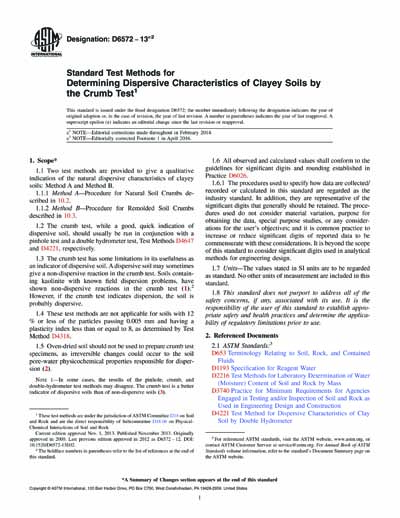Historical
ASTM D6572-13e2
Standard Test Methods for Determining Dispersive Characteristics of Clayey Soils by the Crumb Test
1.1 Two test methods are provided to give a qualitative indication of the natural dispersive characteristics of clayey soils: Method A and Method B.
1.2 The crumb test, while a good, quick indication of dispersive soil, should usually be run in conjunction with a pinhole test and a double hydrometer test, Test Methods D4647 and D4221, respectively.
1.3 The crumb test has some limitations in its usefulness as an indicator of dispersive soil. A dispersive soil may sometimes give a non-dispersive reaction in the crumb test. Soils containing kaolinite with known field dispersion problems, have shown non-dispersive reactions in the crumb test (1).2 However, if the crumb test indicates dispersion, the soil is probably dispersive.
1.4 These test methods are not applicable for soils with 12 % or less of the particles passing 0.005 mm and having a plasticity index less than or equal to 8, as determined by Test Method D4318.
1.5 Oven-dried soil should not be used to prepare crumb test specimens, as irreversible changes could occur to the soil pore-water physicochemical properties responsible for dispersion (2).
1.6 All observed and calculated values shall conform to the guidelines for significant digits and rounding established in Practice D6026.
stated in SI units are to be regarded as standard. No other units of measurement are included in this standard.1.8 This standard does not purport to address all of the safety concerns, if any, associated with its use. It is the responsibility of the user of this standard to establish appropriate safety and health practices and determine the applicability of regulatory limitations prior to use.
ASTM International [astm]

